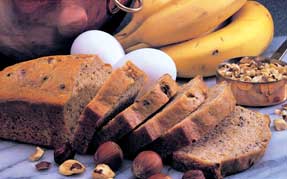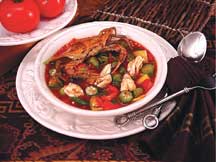

For example, consumers believe blueberry pie should have huge, delicious blueberries that go “pop” when bitten. Pecan cinnamon rolls should have whole nuts that go crunch when chewed, and home meal replacements should have whole green beans.
Whole Food Benefits
Lower quality, processed foods are what they are partially due to cost and processing constraints. However, consumers do not know or care about processing problems such as what shear does to blueberries, or what a single screw pump will do to slices of Yankee pot roast. They want products that rise above being of “acceptable quality” or “meeting specifications.” Starbucks has not achieved its great success by selling inexpensive, acceptable coffee. Although there is a limit to how much a consumer will pay for any food item, Starbucks has proven that the upper limit may be higher than one would think. As consumers become more sophisticated, the culinary bar has been raised for all of the food industry.The use of whole, easily identifiable food ingredients can be one solution in the formulation of desirable, good-for-you foods. People want “wholesome” rather than “healthful” foods. Lowfat, low-calorie foods have (literally) left a bad taste in many consumers’ mouths. And, low cost processed items have made many wary of trying “unidentifiable” discount products. While “high tech” lowfat and low-calorie items may be yesterday’s news, “healthful eating patterns” is today’s trend. Products with a real, natural appearance and mouthfeel say “wholesome” in a way that every demographic group understands.
Ingredient statements also influence the perception of wholesomeness in that many consumers do read labels before they buy a product. The word “pecans” on an ingredient statement means real food. “Raisins” says wholesome in a way that WONF (with other natural flavorings) never will.

Fresh But Consistent
Assuming those in the engineering department solve the problem of maintaining the integrity of whole nuts, berries, seeds, vegetables and fruits throughout processing and packaging, another major challenge still exists. That is, natural, whole agricultural products, by their very nature, are different every time they are harvested.Professional restaurant chefs know this and have turned the challenge into a marketable selling point. For example, the menu at Charlie Trotter’s in Chicago carries “Local, Seasonal, Organic Produce.” Sure it’s inconsistent, but sometimes the offered item is even better than he expects, so more is charged!
However, manufacturers are required to provide customers with consistent quality. How can product formulators do that? To some extent, the same way restaurant chefs do...by developing a deeper understanding of ingredients.
One technique is to categorize whole ingredients by their “level of functionality”; that is, by how much they impact a formula beyond their own presence in a product. A formula’s ingredients can be designated as micro-functional, macro-functional, semi-functional or non-functional.
An agricultural ingredient’s level of functionality differs not only between delivered lots, but also depending upon the type of food in which it is to be used. Those involved in the formulation and/or manufacture of bakery products are well aware of variations in an ingredient’s functionality. Adjusting for the annual changes in the quality of wheat gluten in flour is almost a full-time job for some cereal scientists.
Here’s an imaginary example of how the technique of designating the functionality of “up-scale” ingredients works.
A CEO has just returned from a business trip to Hawaii where he played golf and ate aloha food. His wife found the most wonderful fresh baked “Blueberry-Macadamia Nut Tea Cakes,” which he brings back as the “next big success” for R&D to match. Of course, it must be recreated for one-third the cost and manufactured on existing equipment.
“The whole berries are the key,” the CEO says, “I’m sure it’s easy. Let’s get this done right away.”
The first step is to place needed ingredients into the various functionality categories. The flour, sugar and shortening fall into the “macro” category, but what about the blueberries?
One may first think they should be in the macro-functional category. However, fresh blueberries require special consideration. They bleed dark blue color. They change the pH of the batter, which affects the chemical leavening system. Their flavor changes from delivery to delivery, which may make it desirable to adjust individual production lots by addition of flavors. And, putting the whole, fresh fruit through a high shear transfer pump probably should not even be considered.
On reassessment, fresh blueberries should fall into the micro-functional category. They impact a food system in a great variety of, and often undesirable, ways.
However, there is a way to reduce their influence (or functionality level). An alternative is to use IQF (individually quick frozen) or sweetened dried berries. These modified berries are likely to be more consistent and, hopefully, predictable. Then, to provide the consumer with the “whole berry” experience, a few fresh berries can be deposited on top of the muffin just prior to baking.
Bottom line: incorporating whole food ingredients into a product can be challenging. However, the up-scale quality and standard of gourmet excellence they provide should not be cast aside. The use of whole, big, fresh berries, for example, provides a memorable eating experience. It is that experience that must be recreated.
“Wholesome, fresh prepared, homemade”... are becoming the culinary buzzwords of many prepared foods. Understanding the functionality of whole food ingredients, and using them to create new products that call to mind those buzzwords, will make consumers very happy. And, making people happy should be the goal of every food developer.
Sidebar: Whole Food Ingredient Functionality Checklist
Every ingredient that goes into a formula influences that food’s “matrix.” Ingredients can be categorized by the extent of their influence from great (micro-functional) to relatively little (non-functional).A useful technique is to place “up-scale” whole food and other ingredients into functionality categories when formulating a product, in order to reduce headaches in subsequent development stages. The purpose is to be more aware of, and formulate around, interactions from highly functional and potentially troublesome ingredients.
- Micro-functional: Enzymes, flavors, antioxidants, emulsifiers, chemical preservatives, high-intensity sweeteners
- Macro-functional: Sugars, fats, wheat flour, thickening agents, spinach (for color), most raw fruits, potato flakes
- Semi-functional: Wild rice, skin on-potato, raw vegetables, bran flakes, dried fruits
- Non-functional: Roasted nuts, dried beans, seeds, some bulking agent
Sidebar: Formulating with Colorings
A natural coloring expert graciously supplied the following comment on one challenge in formulating with whole foods.One of the greatest benefits of whole food ingredients, whether intact or cut into identifiable pieces, is the improved appearance they impart to a food. Color is often a critical—yet hard to maintain—element in a commercial product.
People always choose nicely colored products over those with uninviting colors, which can result from color loss or simply a bad choice in color source. With time, most products undergo color shifts of various degrees.
For example, processed strawberries, a natural ingredient, do not preserve their color well and often brown quickly. Formulators may want to consider fruit- and vegetable-based colorants to boost the fruit’s natural shade to overcome the eventual degradation.
Another formulation challenge is the color shift that occurs when a whole food ingredient’s coloring is influenced by pH. For example, when strawberry fruit prep is stirred into a yogurt base, the red fruit tends to impart blue notes to the food. By using an appropriate anthocyanin-based natural coloring, which resists color shifts, the desired red hue in the fruit can be preserved in the yogurt.
Natural colors also bring labeling benefits by providing fruit- and vegetable-based additives for fruit and vegetable ingredients for more consumer appeal.